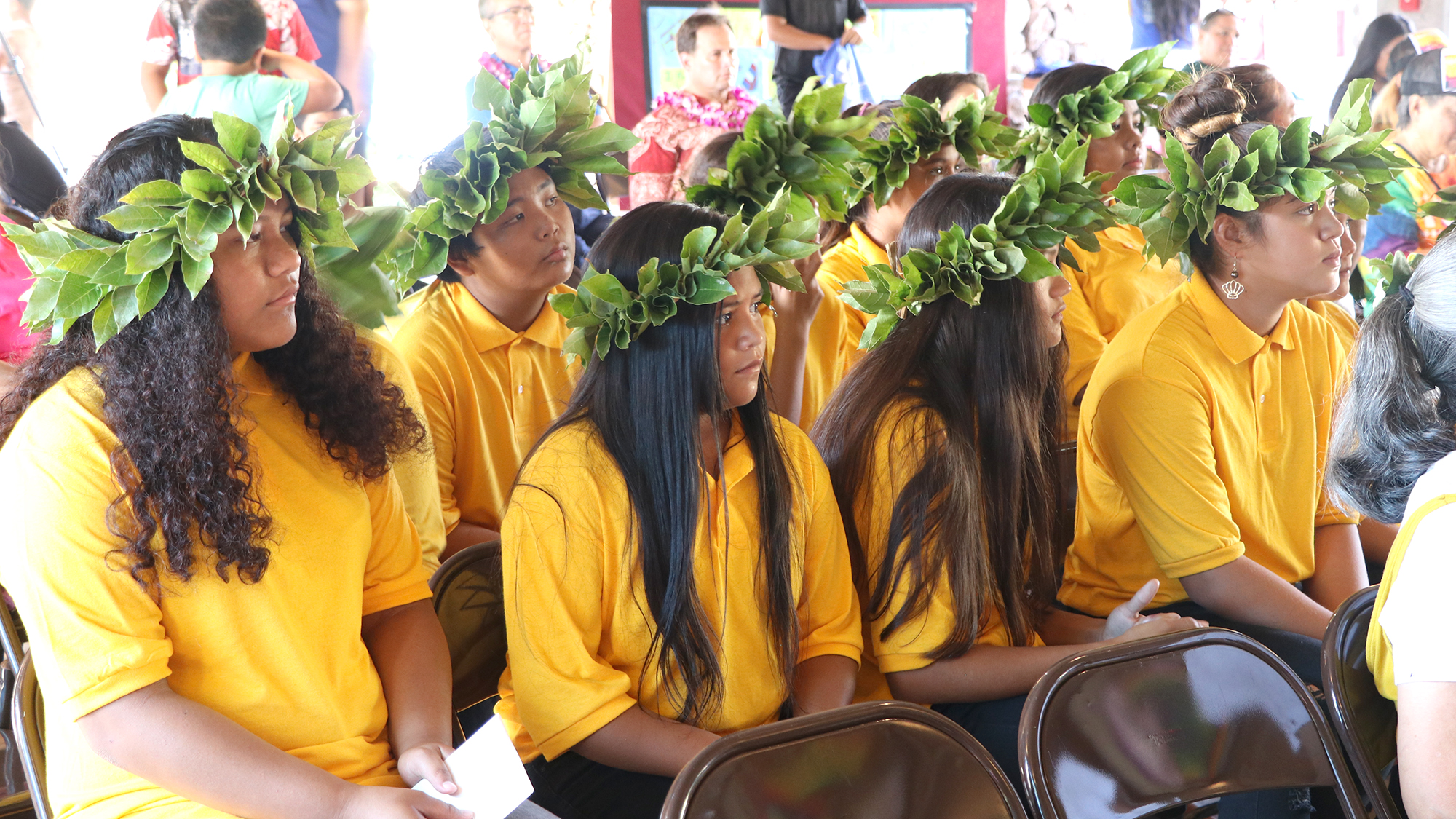The measure would require the weekly disclosure of schools with outbreaks
Updated: Nov. 14, 2019
Only about 100 of the 175 Hawaiian language immersion teaching positions in the state are held by educators licensed to teach in Hawaii who speak Hawaiian, meaning that 43 percent of those classrooms are taught by teachers who are not fully qualified. It’s one more shortcoming that adds to Hawaii’s teacher shortage crisis.
“Throughout the state, we do have a lack of Hawaiian language immersion teachers. We sometimes have to hire teachers who don’t speak Hawaiian to teach certain subjects, especially in the upper levels where there are specialties,” said Hope McKeen, a Hawaiian language immersion special education teacher at Ka Umeke Kaeo Public Charter School in Hilo.
McKeen and other Hawaiian immersion teachers say one of their biggest difficulties is creating their own curriculum.
”We don’t have the opportunity to just go online and download something. We have to create everything on our own,” McKeen said. “We look at the standards, we look at what we have to teach and then we design our entire curriculum. We don’t have a pre-packaged curriculum delivered to us scripted. We have to make it. And so that’s very hard work and it’s a deterrent to many.”
Immersion requires lots of extra work: ‘It’s not just an issue of translating everything’
Leimomi Kaaihili Leong, who teaches SpEd in the kindergarten through third-grade levels at Ke Kula Kaiapuni ‘o Anuenue school on Oahu, says only a few schools can afford to have a resource teacher who is knowledgeable in Hawaiian language immersion education and philosophy to support those in the classroom.
“There are very few curricula, assessment, planning, classroom materials that are rooted in Hawaiian immersion education or even just any native language immersion education,” Leong said. “Hawaiian immersion is not a translated education of English medium education. Therefore it is not just an issue of translating everything.”

“We sometimes have to hire teachers who don’t speak Hawaiian to teach certain subjects.”
Hope McKeen, Ka Umeke Kaeo Public Charter School Hawaiian language immersion special education teacher
Leong’s colleague at Anuenue, Gail Leilani Kamalani, knows those problems first hand since she’s the curriculum and K-12 Title I coordinator there.
“The teacher shortage problem that is plaguing the DOE is exacerbated in Hawaiian immersion schools because, in addition to doing everything that regular teachers do, immersion teachers need to do it in Hawaiian with fewer resources,” Kamalani said.
“Teaching Hawaiian immersion is more difficult than teaching in other settings because teachers need to be Hawaii qualified in whatever grade or subject they are teaching, and they also need to be fluent in Hawaiian. There is also a lack of ready-made instructional materials so immersion teachers spend hours each week creating their own curriculum,” she added.
“Especially at the secondary level, the workload is heavier than at a regular school. Because of small class sizes, teachers may have up to five different classes to prep for (grades 9–12 and elective),” said Kamalani.
“For the most part, immersion teachers feel that being a Kaiapuni teacher is more than just a job, it is a mission,” she said.
Kaui Spitalsky started the Hawaiian language immersion program at Lahainaluna High School four years ago. She was honored last week as the Complex Area Teacher of the Year for the Hana-Lahainaluna-Lanai-Molokai Complex on Maui.
“In the past three years, I’ve taught every single subject except for math, last year, three grade levels, all in Hawaiian language, so you can imagine trying to integrate cultural knowledge with standard-based curriculum to the individual child in Hawaiian language. There’s no curriculum out there. So I struggled, and that struggle is an everyday struggle for all of our kaiapuni teachers,” Spitalsky said.
“There’s no curriculum out there. So I struggled, and that struggle is an everyday struggle for all of our kaiapuni teachers.”
Kaui Spitalsky, Lahainaluna High Hawaiian language immersion teacher

Iolani Kuoha, a Hawaiian language immersion teacher at Molokai Middle School, said, “I think if we can get more of our homegrown teachers, especially our immersion teachers, that will make it so much richer for our community.”
Kuoha’s own daughter works part-time in her classroom and, as Kuoha explains, even she’s hesitant about following in her footsteps “because she sees how difficult things are in immersion, the fact that you have to translate your curriculum, and you have to teach all subjects because there are not enough teachers to teach that subject,” she said. “So she’s been my PPT for three years and she sees the long hours that I put in, and I’m so fortunate that she helps me translate some of the curriculum. She helps me with assessment, and if I could have another person or another teacher like my daughter to come and kokua, I wouldn’t be as stressed out.”
Bonus or differential would help attract more Hawaiian immersion teachers
Creating incentives would help make those Hawaiian immersion teaching lines more attractive, say those devoted to the field.
“Additional pay would definitely help so fewer teachers would need to have second jobs which deplete the energy they could otherwise be spending on their teaching job,” said Kamalani, who teaches at Anuenue on Oahu.
“A hard-to-fill incentive would help, or an incentive like was offered to dual-cert SpEd teachers to return to SpEd. But for older teachers, like myself, I think we should be grandfathered in since when we started teaching, there was no immersion certification available,” she added.
McKeen, the Ka Umeke charter school teacher from Hilo, said, “Compensation would be the biggest, I think, attractor, to ease (the Hawaiian immersion teacher shortage), because for the ones in the older level that have to take double majors, there’s that student loan debt that comes back up. You don’t get extra money for taking a second major. You just have to take it. So compensation I think would be the biggest all around.”
Even a Board of Education policy on Ka Papahana Kaiapuni (Kaiapuni Educational Program) states that: “The goal is for program professionals to be qualified in both English as a medium of instruction and Hawaiian as a medium of instruction and appropriately compensated for these additional qualifications.” Yet no additional compensation exists.
Dual-language educators in California are paid bonuses up to $10K a year
The Los Angeles Unified school district, which is ramping up dual-language English-Spanish instruction, offers an annual stipend of up to $5,406 to teachers with bilingual certification. Statewide, stipends vary from $1,000 (in San Francisco Unified) on up. A few districts pay as much as $5,000 as a hiring bonus. The Sacramento school district pays an extra $5,000 for hard-to-find skills plus a $5,000 “diversity bonus” for experience working with racially, culturally, or academically diverse young people.
HSTA president: ‘We have to expand Hawaiian immersion’
Corey Rosenlee, president of the 13,700-member Hawaii State Teachers Association, said, “Under the state constitution, Hawaiian is one of our two official languages, and as a recent Supreme Court decision pointed out, our children must have access to learn in one of those two languages, and right now in light of that Supreme Court ruling, we’re not providing that.”

“I think if we can get more of our homegrown teachers, especially our immersion teachers, that will make it so much richer for our community.”
Iolani Kuoha, Molokai Middle Hawaiian language immersion teacher
“Hawaiian immersion is a huge need that we have to fill. I think that if we strongly believe in preserving the Hawaiian language and allowing people to get access in their native language, that we have to expand Hawaiian immersion,” Rosenlee added.
The HSTA has advocated for the creation of a bachelor of education in Hawaiian immersion degree and the University of Hawaii at Manoa plans to begin offering that major in the fall of 2021 to help increase the pool of qualified immersion teachers.
As HSTA continues to advocate for our members who work in Hawaiian immersion, we strongly encourage educators to share their thoughts about how we can improve their teaching conditions and contract in our Negotiations Survey. Please take the survey here by Nov. 10.
Hawaiian language immersion education timeline
1987: The State Board of Education (BOE) and Superintendent Charles Toguchi approve the Hawaiian Language Immersion Program (Ka Papahana Kaiapuni Hawaii) on a pilot basis in two schools; Keaukaha Elementary School in Hilo and Waiau Elementary School in Pearl City, Oahu.
1990: Aha Kauleo Kaiapuni Hawaii, the Hawaiian Language Immersion Program advisory council, is established by the BOE.
1998: The Department creates the Hawaiian Language Immersion Program Educational Specialist position. This position is housed in the branch of the department that provides curriculum and instructional support to public schools.
1999: The first two classes of students in Ka Papahana Kaiapuni schools graduate at Ke Kula Kaiapuni o Anuenue, in Palolo, Oahu and at Ke Kula o Nawahiokalaniopuu in Hilo, Hawaii.
2001: Hawaiian Studies and Language Program Policy 2104 is passed. The Board of Education recognizes that appropriate support for and coordination of Hawaiian Studies and Language program is needed to educate all students and ensure the perpetuation of the culture and language of Hawaii.
2008: The Hawaiian Language Immersion Program celebrates 20 years of kaiapuni education within the Department of Education.
2014: In February, a new and more rigorous BOE Policy 2105 is passed unanimously by the Board of Education.
2015: The Office of Hawaiian Education in the HIDOE is officially established in February, elevating its status as a section in the Office of Curriculum, Instruction and Student Support Services (OCISS) to an office under the superintendent’s Office.

